Source: CCTV.com
08-15-2006 14:15
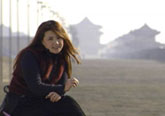 | |
Hi, welcome to travelogue, I am Yanling. Did you enjoy our last trip back to the grand Tang Dynasty? I certainly did. But remember, Xi’an served as the capital city for 13 dynasties.
This time, we are going to dive into the time channel slightly more ambitiously, and take a quick review of the remains of the 13 dynasties. Welcome to Xi’an!
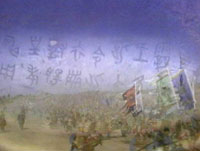 | |
Fertile land along the Yellow River valley outside of Xi’an has always been known as the cradle of Chinese civilization. Ready water, easy access make it a favorite settlement since the age of nomads, plus its strategic location, Xi’an became favorite capital choice of capital among Chinese emperors.
Today it still retains striking marks of ancient majesty. The wealth of historical sites left behind makes Xi’an the no. 2 must- visit- place in china followed by Beijing.
If you are curious about the cultural root and history of ancient china, Xi’an would be your very own wonderland.
 | |
What is like to have the ancient thousand-year-long history condensed in one place and read it at your own pace? This is Shannxi history museum can offer.
A friend of mine once advised me to prepare food and drinks with me when visiting the museum. Because he was so captured by the exhibitions and stayed for 7 hours! He called the experience intoxicated and dehydrating!
It turned out to be a very good advice! It is worth strolling around for hours and even days here.
It is the perfect starting point for one’s trip to Xi’an to get a quick and brief intro to the Chinese ancient history with something more tangible than words.
 | |
China’s longest dynasty Zhou lasted from 1027BC to 221 BC, with lots of sub periods that marks it’s up and downs, and the era ended in its “Warring States Period”, named so because of the power struggle between large states of China that were trying to gain control over the entire area.
 | |
Among the numerous tombs of emperors, gentry and other wealthy people peppers around Xi'an. The one that is almost obligatory for a tourist to visit.
The resting place of Qing Shing Huang, the man who united China and declared himself emperor for the first time in the history.
He was portrayed as one of the most ruthless monarch in the history because of 2 major projects he initiated-- the Great Wall that was meant to protect his empire from enemy from the north, and his own mausoleum that protects him in the nether world.
As the overlord that gained his territory more by enforced military power than by placate, this is of course something he would not forget to take with him!!
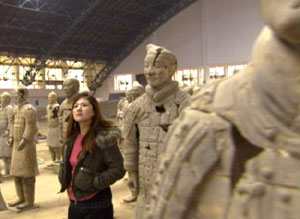 | |
Trade mark of Xi’an today, the reason that most visitors to China put Xi’an in their itinerary, the only excavated items revealing some secrets of the Emperor Qing’s Mausoleum—terracotta soldiers!
Like most Xi’an archeological finds, the first terracotta soldier was discovered accidentally by farmers when digging a well. At that point, no one was sure how many of figures like these lying under the 5-meter deep pit. Massive archaeological excavations were set off after 1974 and still going on.
Originally, they were all hand-painted but time and the exposure to modern air and light has caused them to lose their luster.
Tests also show that the pottery figures were fired at temperatures o bet 950 to 1050 with a level of skill that experts today have difficult to replicate with consistency.
There are not many mystery around the purpose of having a project like this done ordered by the first emperor. Live burial was an old practice among the Qin. The practice is called "xun" and makes "following to the grave" have a new meaning. The people who were buried with the ruler were supposed to continue to protect and serve.
Han (206 B.C.-220 A.D.)
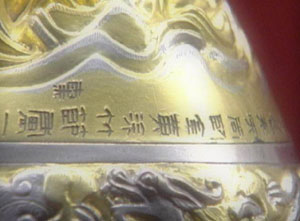 | |
Chinese people started to be known as Han people and the Chinese language was also called Han language by neighboring countries, started from this period.
Han emperors followed Confucius doctrine of reigning with benevolence, working on mass’s wellbeing and rebuilding economy and keeping peace with neighboring countries.
Japan and Korea and many other surrounding countries sent delegates to pay tribute to China. Unlike the Qin, they allowed the cultures of the new territories to remain intact and encouraged trade and commerce among the various parts of the empire.
Emperor Wudi sent out envoy Zhang Qian twice to visiting neighboring states, bringing large delegations and items to trade.
Silk was an immediate hit. And the route he took became known as the Silk Road.
The Silk Road effects were immediate to China as well. Fuelled by an insatiable appetite for foreign exotica, new products were introduced from the west including pomegranates, grape vines, and fine horses.
But the real benefits are less tangible. It fires the imagination to find that other’s thoughts can be different from one's own; and exchange of ideas enriches the content of a culture rather than endangers its identity.
People in China really adapted this idea in the grand Tang Dynasty.
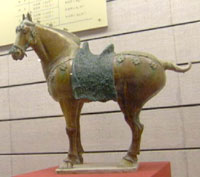 | |
 | |
The artwork from Tang Dynasty looks most colorful and grandiose, among the most valuable of Shannxi history museum’s collection.
The famous Tricolor glazed pottery, an exquisite art form that combines ceramics and sculpture was invented in this period.
Song artists continued to perfect the technique and many porcelain kilns were built throughout of China. Yaozhou kiln’s products are still considered as among the finest examples of porcelain making in China.
Black porcelain cater to my own taste with its grandiose look, but I have to admit the pieces that really bring fame to Yaozhou kiln—celadon of vivid yet subtle color glaze really are work of art.
The most outstanding accomplishment of Yaozhou kiln porcelain was its decorative patterns. In Song Dynasty, there are many porcelain and carving schools established around Yaozhou.
What makes a craftsman an artist? I don’t have a ready answer. But I am sure what I saw here was the work of art:
 | |
As a tourist, it is quite an experience to have robes on, hands on and the look of making of pottery. I know practice makes perfection, but I have no excuse for my karaoke skills.
To learn about history, most likely you have no other choice but reading hefty history books. In Xi’an, you have a better option—to read more hefty ones in the so-called “stone library”
Stele forest museum was converted from a Confucius temple in 11 century originally, and became the treasure house for storing stone engraved classics ever since.
It is not a place to skip even if you don’t read Chinese, Picasso understood that very well by saying, had he been born Chinese, he would have been a calligrapher, not a painter.
Like all art, it is best to simply look at them for enjoyment.
 | |
Calligraphy, together with painting, music and chess are considered to be one of the four basic skills and disciplines of the Chinese literati. It is also believe to polish ones skill of calligraphy, is also one of means of cultivating one’s mind.
Stone library deserves its name because of Rubbing, which makes possible for one to take a “book” home.
The most lively neighborhood in Xi’an is here—the Muslim district.
Xi’an Muslims, identified with their unique life style and religion—Islam. Locally are known as “Hui” minority. They are descended from the Arab and Iranian traders who were active along the Silk Road, living reminder of Xian's former busy street scene as the center of commerce.
 | |
Their lifestyle has also influenced the rest of the citizen. As the matter of fact, the trade mark cuisine from Xi’an is known as “lamb bread”, originally a Muslim dish.
Two of my Dutch fellow travelers found the idea of “dipping the bread into a mutton soap” not very appealing. But I managed to convince them to be open- minded about it and have a try!
The point of this dish is it is half- self – serving. The bread is just an ingrediance of the dish but a very important one, therefore, the most time- consuming part in preparation.
Don’t know how tasteful a piece of bread can be, I am sure at least it serves a social function—while you breaking it into small pieces, you break the ice with your fellow dinners.
The name of this dish “mutton soup dipped bread” should not be taken literally. The bread is actually stir-fried with vegetable, rice noodles and lamb or beef sauce afterwards catering to your own preference.
The great mosque, the center of Xi’an Muslims spiritual life is tugged away at a quiet corner of the busy street.
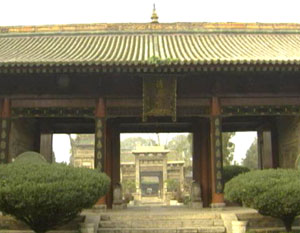 | |
It was originally built in the Tang Dynasty. Tang people were known for their sophisticated understanding of the outside world and a great confidence in adapting and assimilating foreign ideas into Chinese contexts. The grand mosque architecture clearly embodies both Chinese and Islamic features.
As for night entertainment, there are 2 options in Xi’an for a tourist—seeing the history play alive and seeing the history playing alive in another way.
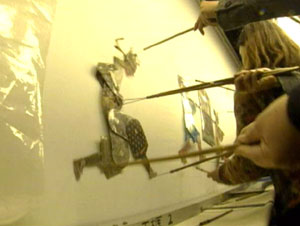 | |
There are Tang style dance shows performed by local dancers, and these, shadow puppet show. If you go for authentically traditional, it is a better choice.
Did you enjoy our special trip to xi an as much as I did? I certainly hope so. One of deeply rooted believes in china is – history is a reflection mirror, it tells us where we came from and guide us to move on. To understand china, you have to come to xi an! Stay warm, I see you next time!
Editor:Chen Minji

